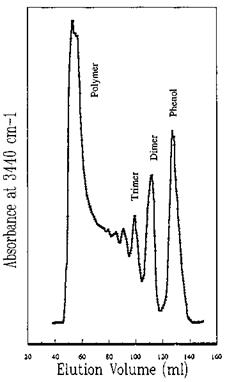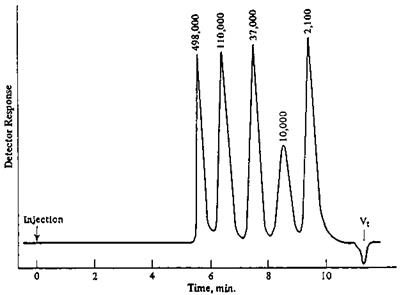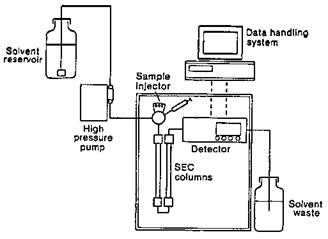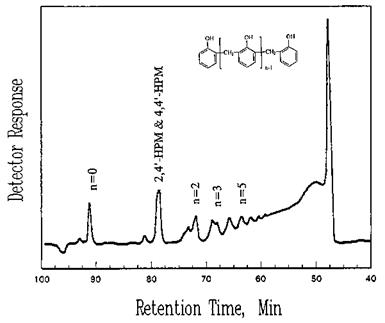The technique of GPC or SEC is introduced for determination of the molecular weight and MWD of adhesive polymers, separation of small molecules, and preparation of molecular weight fractions. This technique is possibly the most widely used chromatographic technique in polymer analysis. It is capable of characterizing very high-molecular-weight polymers up to 106, thermoset resins of molecular weight 103 and 104, and oligomers or prepolymers in which only a few monomer units are joined. Several valuable texts are available on this subject [3,4].
Gel permeation chromatography or SEC is a liquid column chromatographic technique in which an adhesive solution is introduced onto a column packed with a rigid porous gel and is carried through the column by a solvent or solvents (mobile phase). Ideally, size separation is achieved by differential pore permeation. Under the influence of the solvent stream passing down the column, the smaller molecules in the adhesive go into and out of more pores in the packing than do the larger molecules. Hence larger molecules are eluted from the column earlier than smaller ones and are detected by means of some suitable instruments. A more detailed discussion on the separation is available [5]. The separation is based on the hydrodynamic volume of a polymer molecule. This hydrodynamic volume is converted to a molecular weight or equivalent molecular weight compared to the hydrodynamic volume of a calibrated polymer by means of a calibration curve (see Fig. 3a). Specific molecular weights in GPC can be determined only from a calibration curve. Calibration requires chromatographing several samples of the specific polymer type that have narrow molecular weight distributions and known molecular weights covering the entire range of interest. For example, a gel permeation chromatogram of polystyrene standards with various molecular weights is shown in Fig. 4. The peak retention volumes of the sample are then plotted graphically against the known molecular weight average. The molecular weight average of the unknown is determined from the calibration plot and the peak retention volume and is in the units of the calibration curve, Mw, Mn, or Mv.
In GPC or SEC the distribution coefficient of a solute species is defined [6] in terms of the fraction of the intraparticle volume, Vs, which is accessible to the solute so that
![]() V — Vm
V — Vm
Vs
and
Vt = Vm + KVs (9)
For large, totally excluded molecules, Vt = Vm and hence K = 0. For small solute molecules which can enter all the pores, Vt = Vm+Vs and hence K= 1. Separation therefore occurs only where solute molecules obey the condition 0< K < 1. Figure 3b is a typical gel permeation chromatogram. Notice that the first peak to be eluted corresponds to the largest molecular weight species in the sample. It should be noted that GPC requires the polymer sample to be dissolved in a solvent. For this reason, cross-linked adhesives cannot be analyzed by the GPC technique.
The essential components of the instrumentation (Fig. 5) are a solvent reservoir, a solvent delivery system (high pressure pump), sample injection system, packed columns,
|
chromatography: (a) calibration curve; (b) chromatogram. |
detector(s), and a data handling system. The heart of the instrumentation is the fractionation column where the separation takes place. The most common packing material used has been a semirigid cross-linked polystyrene gel. The concentration of the polymer molecules eluting from GPC columns is monitored continously by a detector. The most widely used detector in GPC is the differential refractometer, which measures the difference in refractive index between solvent and solute. Other detectors commonly used for GPC are a functional group detector and an ultraviolet detector. Chromatograms obtained on a phenolic resin to determine the oligomers and on a phenol-formaldehyde (PF) prepolymer adhesive are shown in Figs. 6 and 7, respectively. As discussed earlier, the various fractions of the polymer can be estimated from a calibration curve. Determination of the MWD and kinetic investigations of PF adhesives have been reported [7-10]. Resorcinol-
|
Figure 4 Gel permeation chromatogram of polystyrene standards with various molecular weights. |
|
Figure 5 Equipment schematic for a typical gel permeation chromatograph. |
formaldehyde condensates have been characterized [11]. The use of N, N-dimethylforma — mide (DMF) as a solvent with Poragel/Styragel columns allows analysis of PF melamine — formaldehyde condensates [12]. Epoxy resins have been characterized by GPC under various conditions depending on their molecular weights. Typically, tetrahydrofuran is used as the solvent and ultraviolet absorption as the detection mode. For low-molecular — weight resins, less than 1,000, the uses of Biorad SX-2 and combinations of Styragel and Biorad SX-2 for higher-molecular-weight materials have been reported [13].
|
|
|

 10 июля, 2015
10 июля, 2015  Malyar
Malyar 



 Опубликовано в рубрике
Опубликовано в рубрике 